
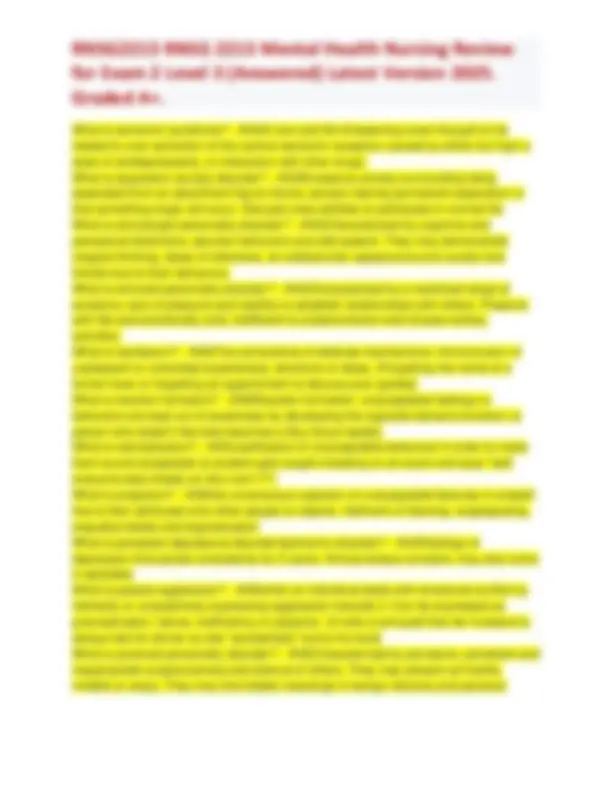
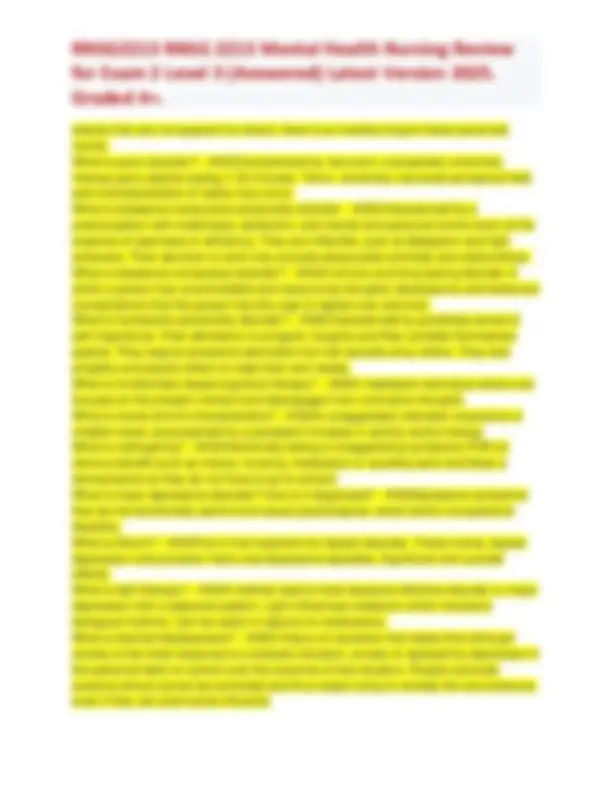
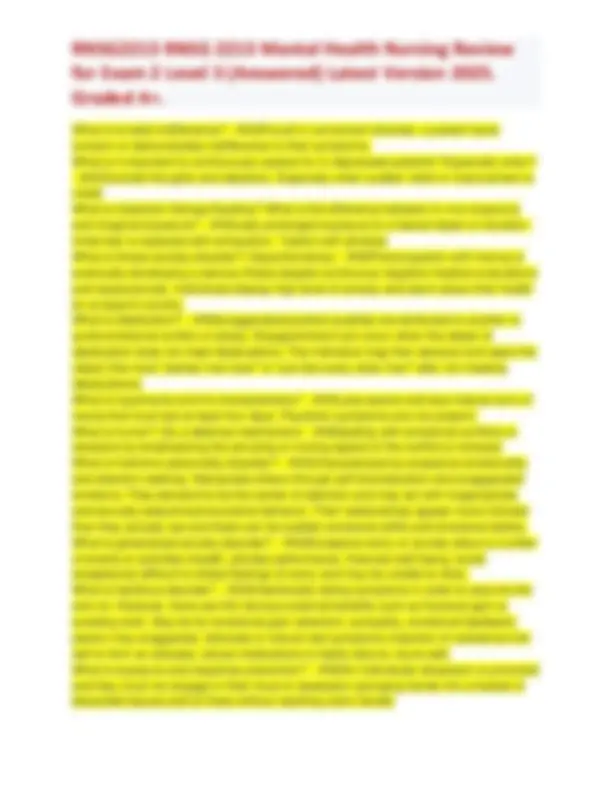
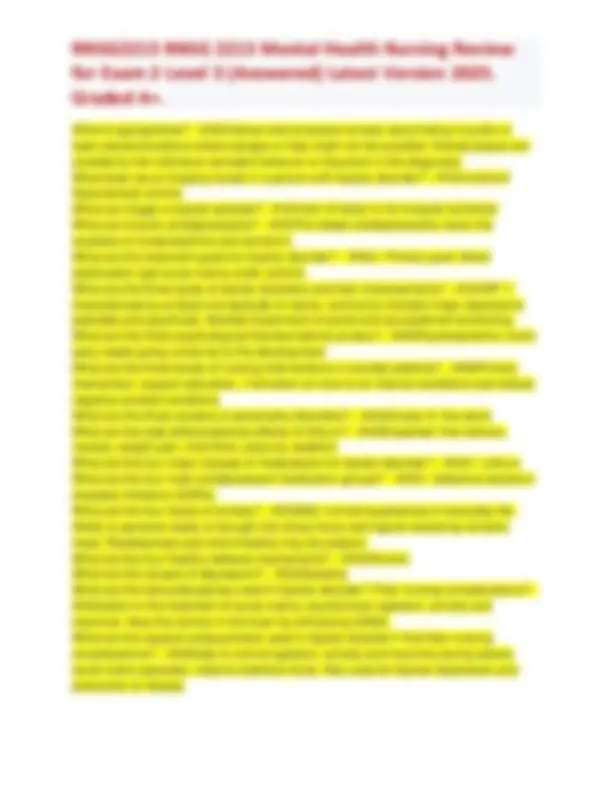
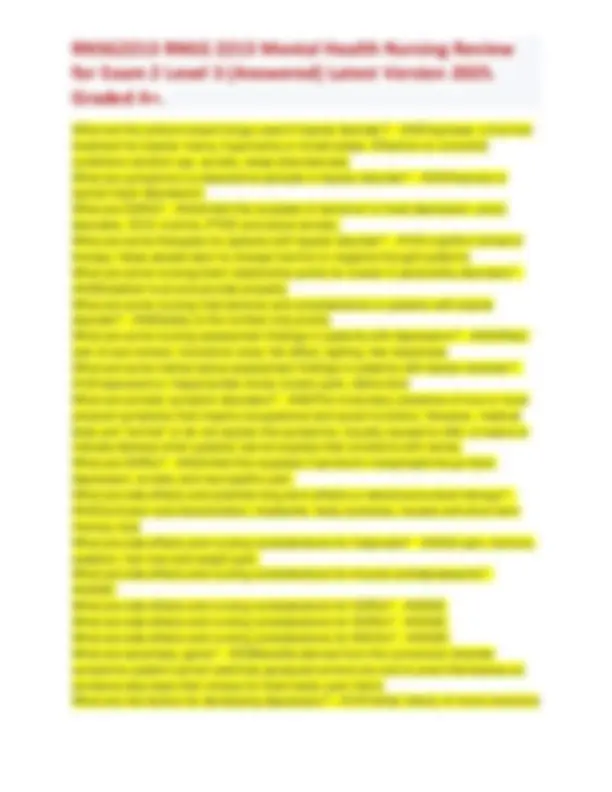
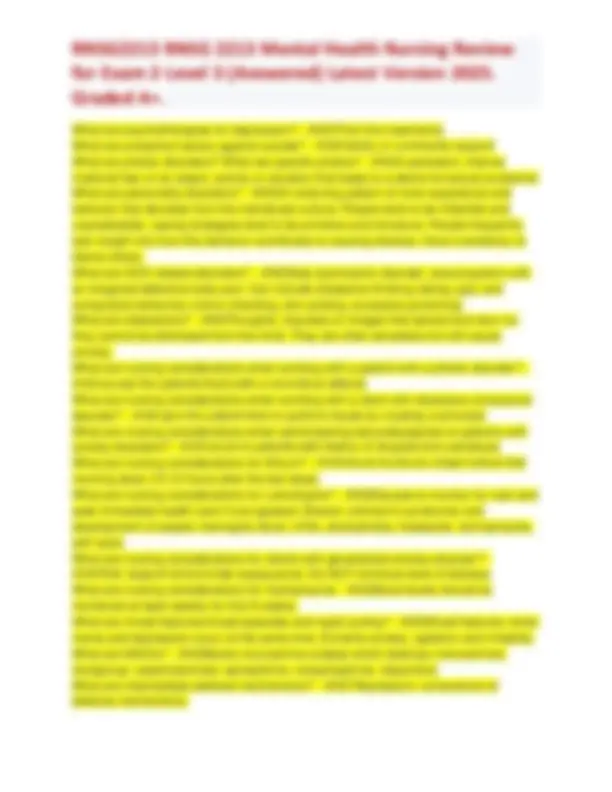
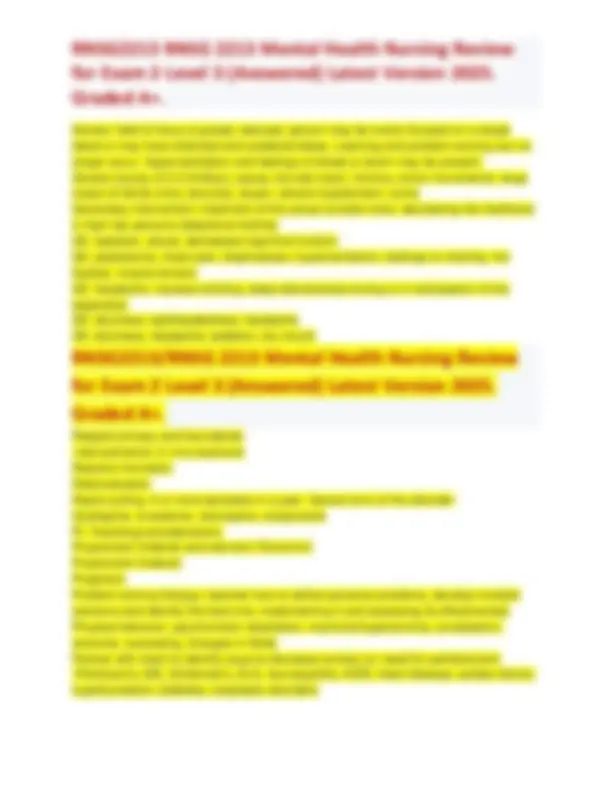
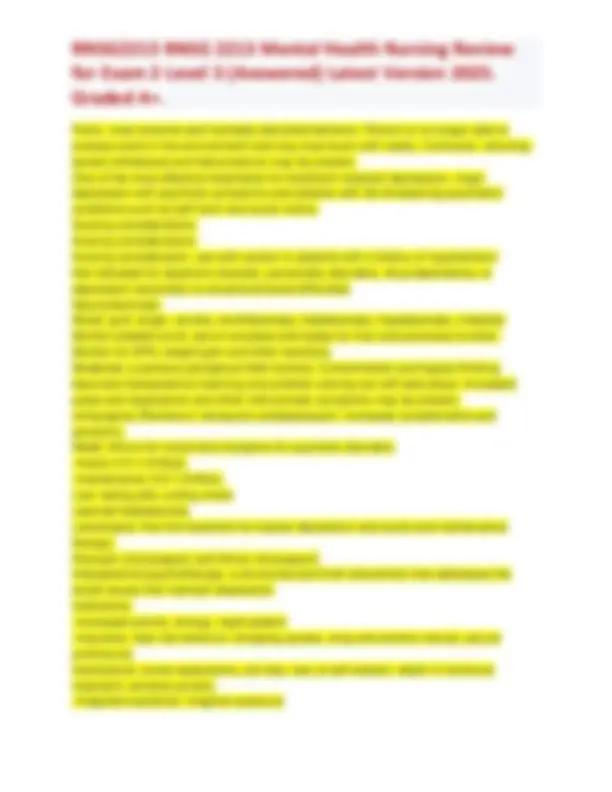
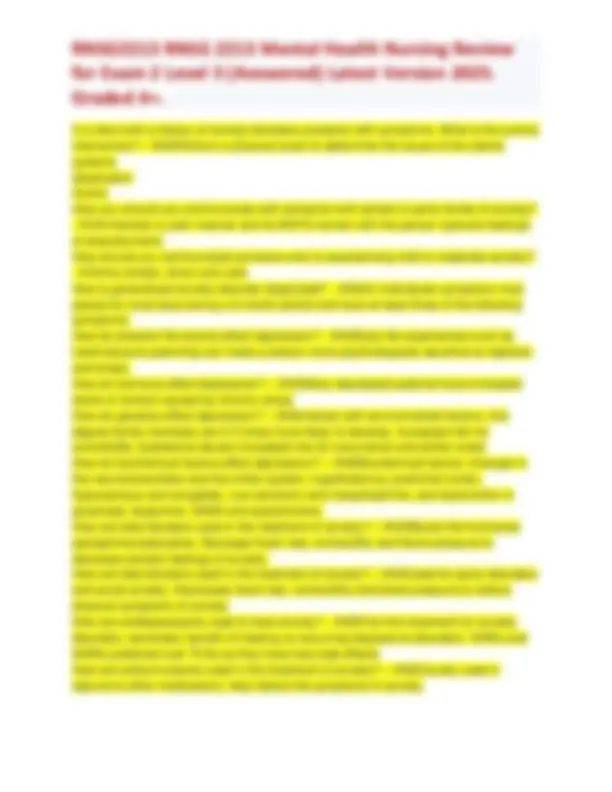
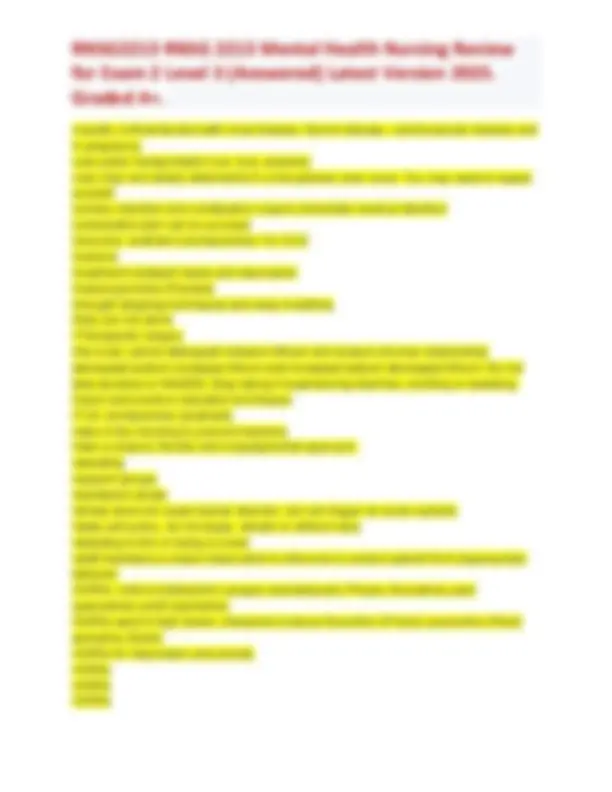
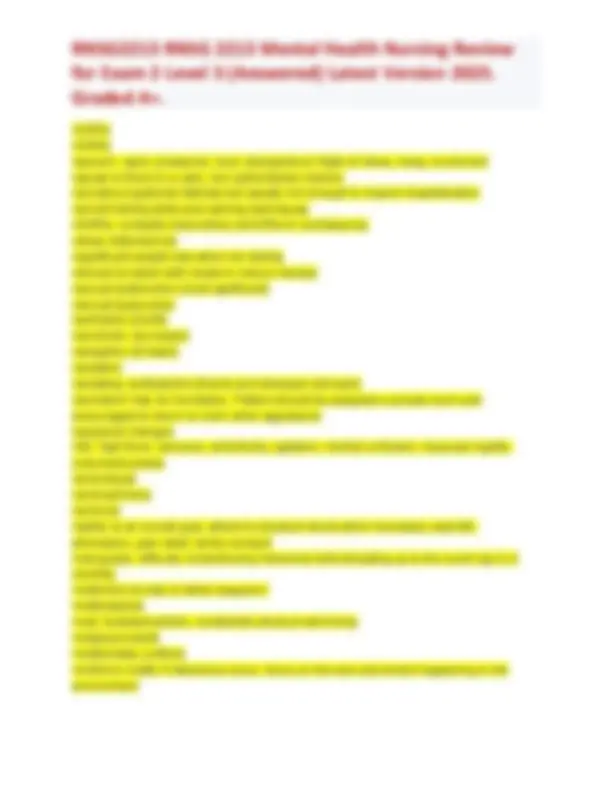
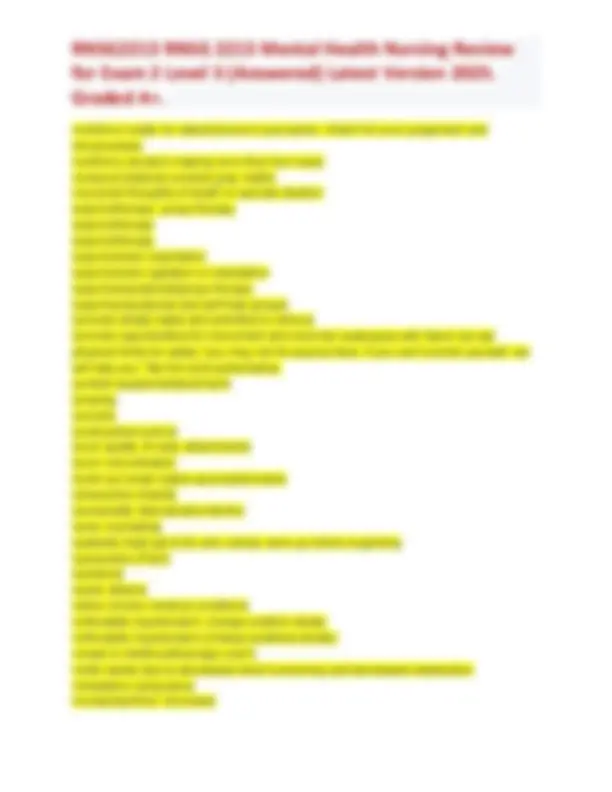
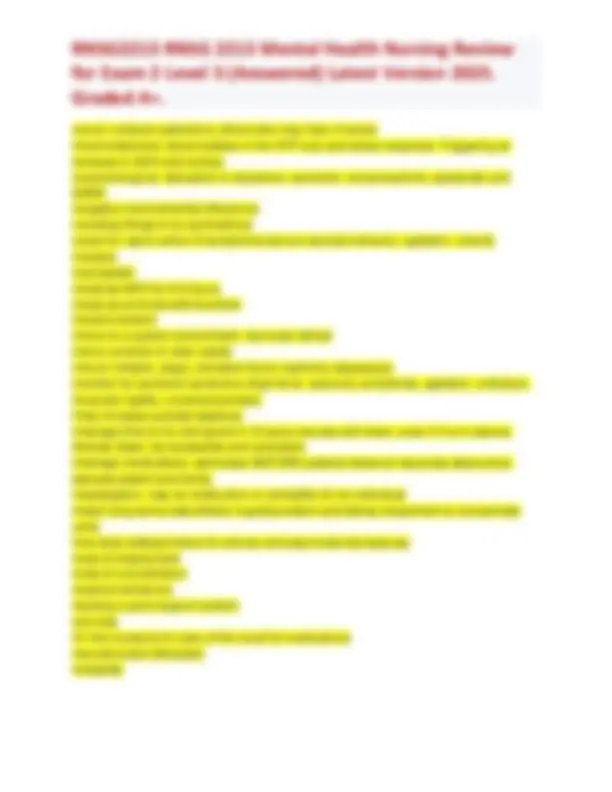
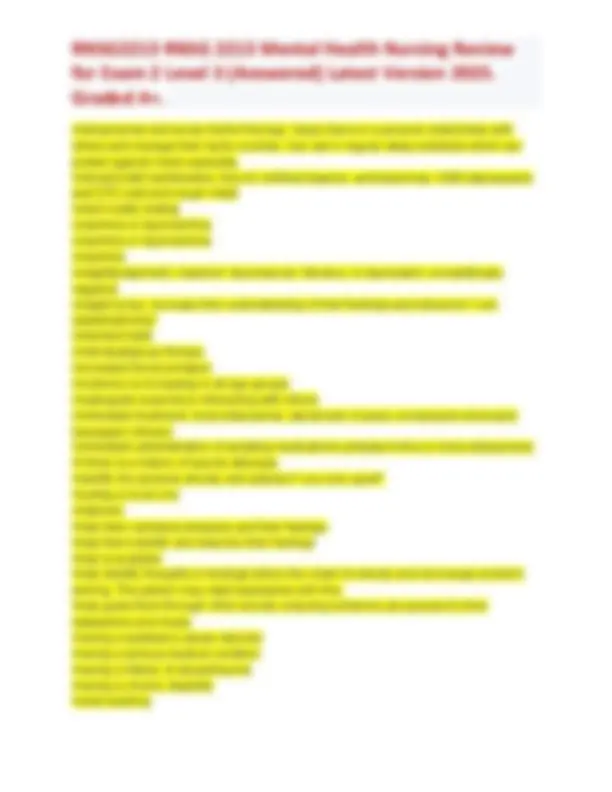
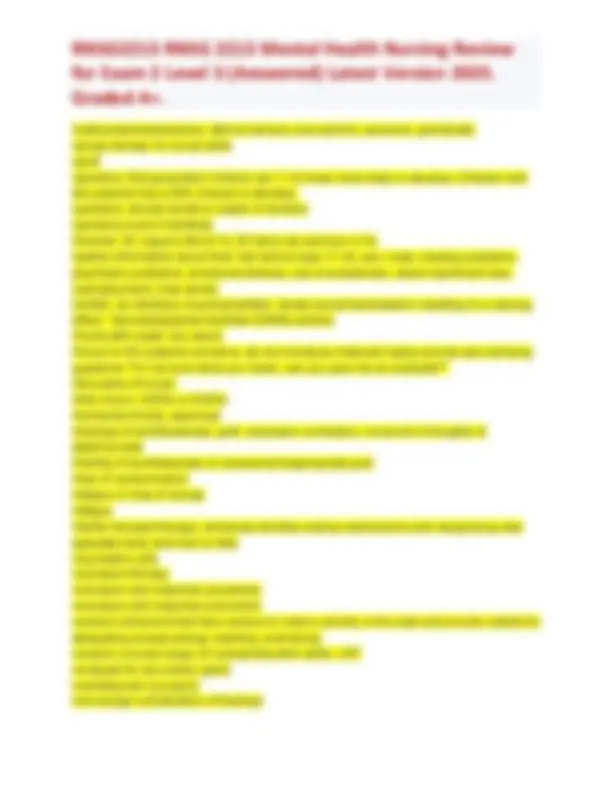
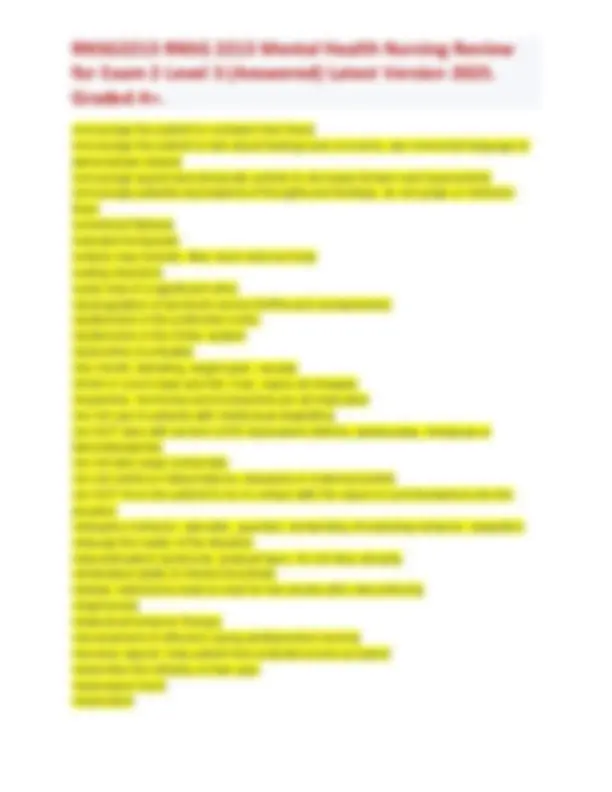
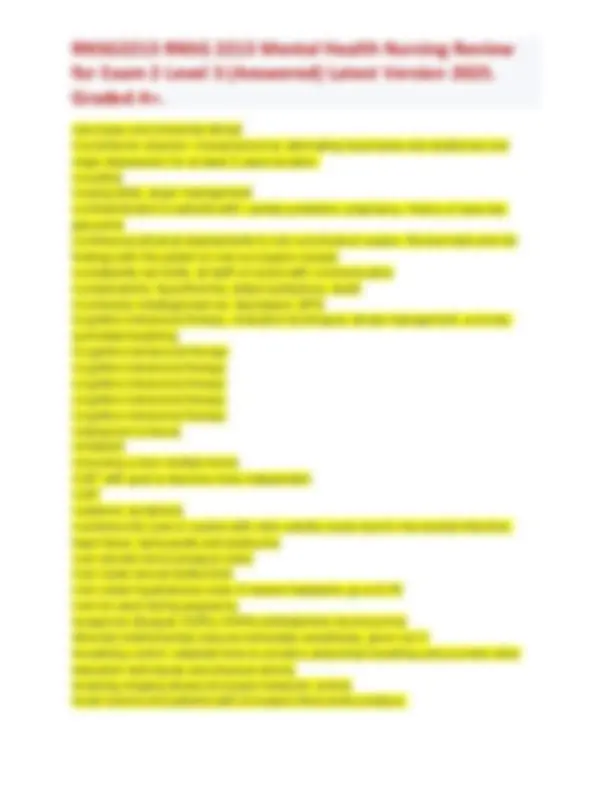
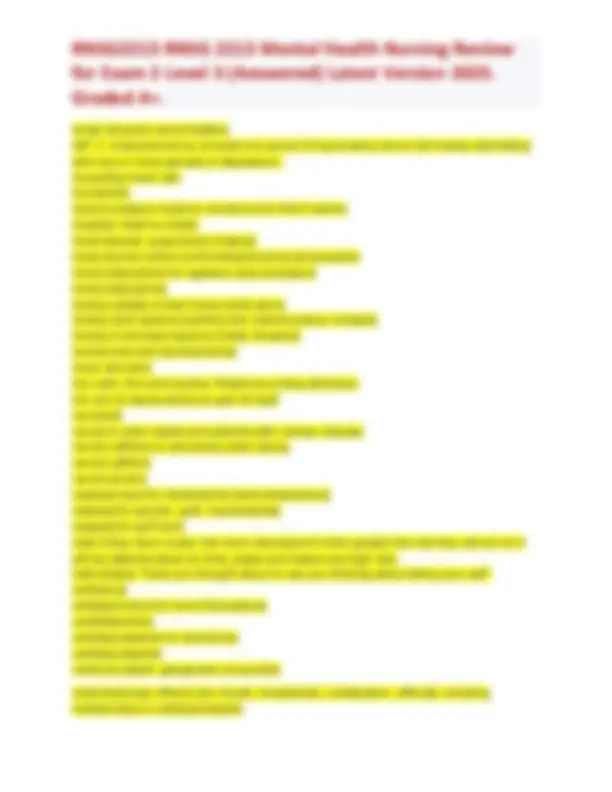
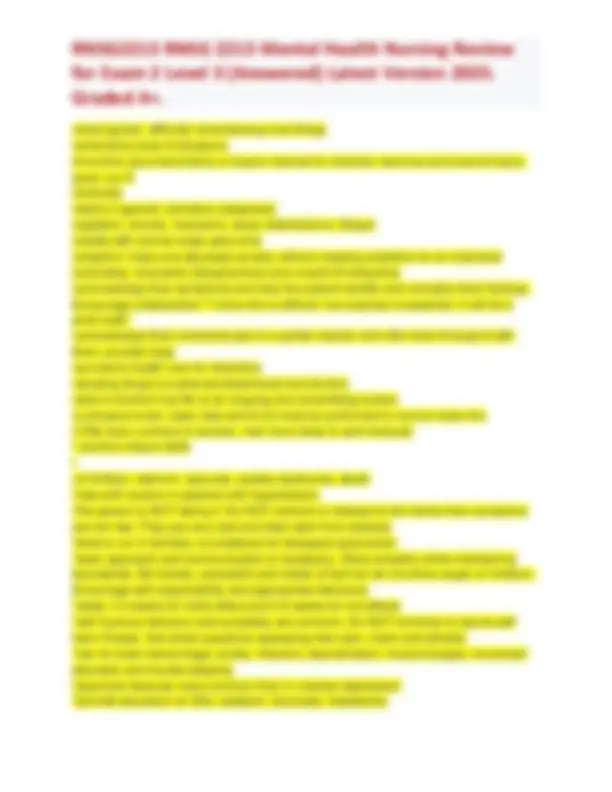
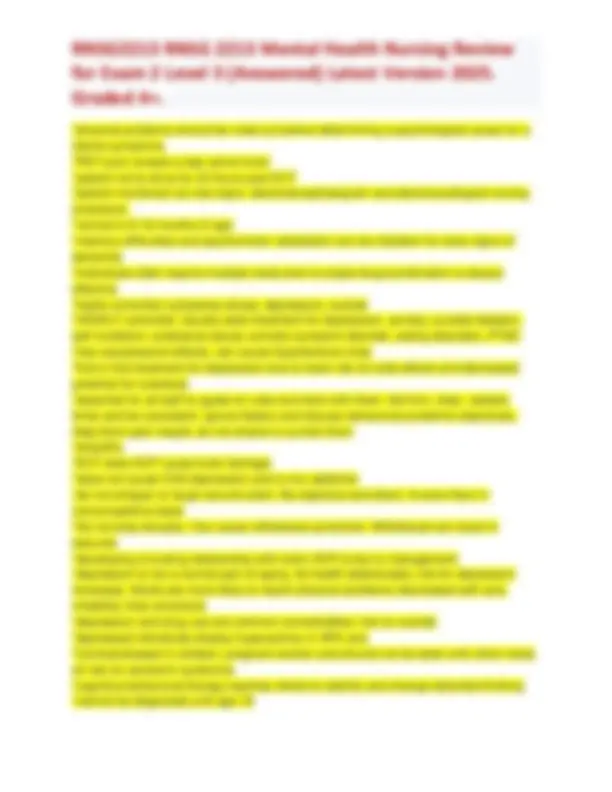
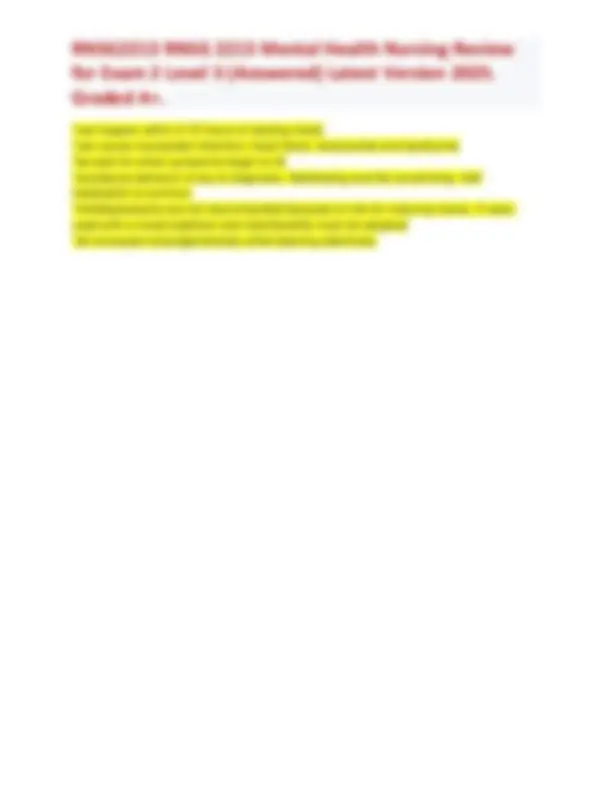









Study with the several resources on Docsity

Earn points by helping other students or get them with a premium plan


Prepare for your exams
Study with the several resources on Docsity

Earn points to download
Earn points by helping other students or get them with a premium plan
Community
Ask the community for help and clear up your study doubts
Discover the best universities in your country according to Docsity users
Free resources
Download our free guides on studying techniques, anxiety management strategies, and thesis advice from Docsity tutors
RNSG2213 RNSG 2213 Mental Health Nursing Review for Exam 2 Level 3 (Answered) Latest Version 2025 Graded A+..pdf
Typology: Exams
1 / 36

This page cannot be seen from the preview
Don't miss anything!





























What's the classes of medications used in the treatment of anxiety? - ANS•Antidepressants (SSRIs, SNRIs, TCAs, buspar) What's are some nurse/client relationship points for cluster A personality disorders? - ANSBuild trust What should be conveyed when speaking to a person who is suicidal? - ANS•the crisis is temporary What sets agoraphobia apart from a simple phobia and acute anxiety? - ANSThe following cause significant distress: What must be done before ECT can be performed? - ANS•Informed consent must be obtained after giving a written and oral explanation to the patient. What medications are usually given before and during electroconvulsive therapy? - ANS•Glycopyrolate: an anticholinergic to decrease secretions What medications are used for conversion disorder? - ANSSSRIs: help with comorbid anxiety and depression. Also decreases sensitivity to bodily sensations. fluoxetine (Prozac) paroxetine (Paxil) sertraline (Zoloft) What is vagus nerve stimulation? - ANSLong-term treatment for patients with treatment- resistant depression. A pulse generator is surgically implanted into the upper left chest, connected by a wire to the vagus nerve. When the generator is stimulated, electrical impulses are transmitted to the brain. What is undoing? - ANSperforming and action to "make up" for a previous behavior (giving a gift to "undo" and argument) What is transcranial magnetic stimulation? - ANSNoninvasive electromagnetism used to treat treatment-resistant depression and anxiety disorders. An electromagnetic coil is placed near the scalp to deliver magnetic pulses and produce electrical field to the cerebral cortices that stimulates nerve cells responsible for mood control and depression. Considered safer than ECT and has minimal side effects. What is therapeutic milieu/milieu therapy for patients with bipolar disorder? - ANSAn atmosphere with decreased stimuli What is the stress-diathesis model of depression? - ANSA biopsychosocial theory that explains depression from an environmental, interpersonal and life-events perspective (stress) combined with biological vulnerability/predisposition (diathesis). States that stressful events can cause brain changes that lead to depression in a vulnerable brain. What is the nursing assessment for patients who are suicidal? - ANS•identify current feeling states (depression, hopelessness, anxiety or panic, loss of interest, loss of sleep) What is the most common comorbidity with depression? What are some others? - ANS1. Anxiety (70%)
What is the etiology of obsessive compulsive disorder? - ANSUsually starts in late teens or early 20s. Biological and neurologically based. Significant genetic component as well. What is the etiology of bipolar disorders and the three main causes? - ANSNo single cause but there are multiple variables: What is the etiology of anxiety disorders? - ANSNeurobiology: dysfunction of the límbico system (frontal cortex, hypothalamus, hippocampus and *amygdala) What is the etiology for social phobia/social anxiety disorder? - ANS•having a first generation relative with the disorder What is the epidemiology of depression? - ANS•most common psychiatric disorder and leading cause of disability world wide What is the epidemiology of bipolar disorders and what are the common misdiagnosis?
attacks that are not apparent to others, there is an inability forgive these perceived insults. What is panic disorder? - ANSCharacterized by recurrent, unexpected, extremely intense panic attacks lasting 1-30 minutes. Terror, extremely narrowed perceptual field and misinterpretation of reality may occur. What is obsessive-compulsive personality disorder - ANSCharacterized by a preoccupation with orderliness, perfection, and mental and personal control even at the expense of openness or efficiency. They are inflexible, poor at delegation and high achievers. Their devotion to work may exclude pleasurable activities and relationships. What is obsessive compulsive disorder? - ANSA chronic and long lasting disorder in which a person has uncontrollable and reoccurring thoughts (obsessions) and behaviors (compulsions) that the person has the urge to repeat over and over. What is narcissistic personality disorder? - ANSCharacterized by grandiose sense of self importance. Their demeanor is arrogant, haughty and they consider themselves special. They require excessive admiration but nah secretly envy others. They lack empathy and exploit others to meet their own needs. What is mindfulness-based cognitive therapy? - ANSA meditation technique where one focuses on the present moment and disengages from ruminative thoughts What is mania and it's characteristics? - ANSAn exaggerated, elevated, expansive or irritable mood, accompanied by a persistent increase in activity and/or energy What is malingering? - ANSIntentionally taking or exaggerating symptoms FOR an obvious benefit such as money, housing, medication or avoiding work (kid fakes a stomachache so they do not have to go to school) What is major depressive disorder? How is it diagnosed? - ANSDepressive symptoms that can be emotionally painful and cause psychological, social and/or occupational disability. What is lithium? - ANSFirst in line treatment for bipolar disorder. Treats mania, bipolar depression and prevents manic and depressive episodes. Significant anti-suicidal effects. What is light therapy? - ANSA method used to treat seasonal affective disorder or major depression with a seasonal pattern. Light influences melatonin which maintains biological rhythms. Can be useful in adjunct to medications. What is learned helplessness? - ANSA theory of causation that states that although anxiety is the initial response to a stressful situation, anxiety is replaced by depression if the personal feels no control over the outcome of that situation. People conclude aversive stimuli cannot be controlled and thus cease trying to remedy the circumstance, even if they can exert some influence
What is la belle indifference? - ANSFound in conversion disorder, a patient lacks concern or demonstrates indifference to their symptoms. What is it important to continuously assess for in depressed patients? Especially when?
emotional distress or psychological impairment despite clinical findings being incongruent with the anatomy, physiology or known disease. Symptoms may be incongruent at times. (Person with a "paralyzed arm" has normal deep tendon reflexes) What is cognitive theory? - ANSApplication of cognitive behavioral therapy to depression. Proposes that people acquire a predisposition to depression through early life experiences. These experience contribute to negative, illogical and irrational thought processes that maybe become activated during stress. Causing depressed individuals to misinterpret/process information in a negative/distorted way. What is Buspar (buspirone)? - ANSA non-benzodiazepine anxiolytic used in the long term maintenance of chronic anxiety. Binds to serotonin and dopamine receptors. What is borderline personality disorder? - ANSCharacterized by unstable mood and self image, marked impulsivity and splitting. There is difficulty with self regulations and an inability to soothe oneself during times of stress. Individuals have unstable relationships characterized by alternation between idealizations and devaluation. They fear abandonment. What is avoidant personality disorder? - ANSCharacterized by high levels of anxiety and outward fear with feeling sit low self-worth. They are hyper sensitive to criticism, rejection and tent to avoid situations that require socializaron. They have very poor self esteem, often viewing themselves are socially inept, personally unappealing or inferior to others and are reluctant to take risks for fear of embarrassment or inadequacy. What is aversion therapy? - ANSan undesirable behavior is associated with an unpleasant stimuli (taking a drug that causes vomiting when mixed with alcohol, thus the person will not want to drink when they smell alcohol as this produces memories of vomiting) What is anxiety? - ANSA feeling of apprehension, uneasiness, uncertainty or dread resulting from a real or perceived threat whose actual source is unknown or unrecognized. What is antisocial personality disorder? - ANSCharacterized by a persistent disregard and violation of the rights of others, with a lack of remorse for actions and hurting others. Can be charming or charismatic and have a sense of entitlement. They are selfish, manipulative and disinhibited and there is frequently a history of lying, deception, conning of others for profit or pleasure and disregard for the law and rights of others. May engage in risky and dangerous behaviors. What is altruism? - ANSemotional conflicts and stressors are addressed by meeting the needs of others, the person recurves gratification either vicariously or from the responses of others (after a personal tragedy, one becomes a volunteer to help others going through the same experience)
What is agoraphobia? - ANSIntense and excessive anxiety about being in public or open places/situations where escape or help might not be possible. Feared places are avoided by the individual (avoidant behavior is important in the diagnosis) What does neuro-imaging reveal in a person with bipolar disorder? - ANS•reduced hippocampal volume What can trigger a bipolar episode? - ANS•lack of sleep or an irregular schedule What are tricyclic antidepressants? - ANSThe oldest antidepressants, block the reuptake of norepinephrine and serotonin What are the treatment goals for bipolar disorder? - ANS1. Primary goal: Mood stabilization (get acute mania under control) What are the three types of bipolar disorders and their characteristics? - ANS•BP 1: characterized by at least one episode of mania, commonly includes major depressive episodes and psychosis. Marked impairment of social and occupational functioning. What are the three psychological theories behind anxiety? - ANSPsychodynamic: one's early needs going unmet let to the development What are the three levels of nursing interventions in suicidal patients? - ANSPrimary intervention: support education, I formation on how to en chance conditions and reduce negative societal conditions What are the three clusters of personality disorders? - ANSCluster A: the weird What are the side effects/adverse effects of lithium? - ANSExpected: fine tremors, nausea, weight gain, mild thirst, polyuria, sedation What are the four major classes of medications for bipolar disorder? - ANS1. Lithium What are the four main antidepressant medication groups? - ANS1. Selective serotonin reuptake inhibitors (SSRIs) What are the four levels of anxiety? - ANSMild: normal experiences of everyday life. Ability to perceive reality is brought into sharp focus and logical reasoning remains intact. Restlessness and mild irritability may be present. What are the four healthy defense mechanisms? - ANSAltruism What are the causes of depression? - ANSGenetics What are the benzodiazepines used in bipolar disorder? Their nursing considerations? - ANSUseful in the treatment of acute mania, psychomotor agitation, anxiety and insomnia. Slow the activity in the brain by enhancing GABA. What are the atypical antipsychotics used in bipolar disorder? And their nursing considerations? - ANSHelp to control agitation, anxiety and insomnia during severe acute manic episodes. Used to stabilize mood. Also used for bipolar depression and prevention of relapse
What are psychotherapies for depression? - ANSFirst line treatments What are protective factors against suicide? - ANS•family or community support What are phobic disorders? What are specific phobia? - ANSA persistent, intense irrational fear of an object, activity or situation that leads to a desire for/actual avoidance What are personality disorders? - ANSAn enduring pattern of inner experience and behavior that deviates from the individuals culture. People tend to be inflexible and unpredictable, coping strategies tend to be primitive and immature. People frequently lack insight into how this behavior contributes to causing distress. Have a tendency to blame others. What are OCD related disorders? - ANSBody dysmorphic disorder: preoccupation with an imagined defective body part. Can include obsessive thinking (being ugly) and compulsive behaviors (mirror checking, skin picking, excessive grooming) What are obsessions? - ANSThoughts, impulses or images that persist and recur so they cannot be dismissed from the mind. They are often senseless but still cause anxiety. What are nursing considerations when working with a patient with a phobic disorder? - ANS•accept the patients fears with a noncritical attitude What are nursing considerations when working with a client with obsessive compulsive disorder? - ANS•give the patient time to perform rituals by creating a schedule What are nursing considerations when administering benzodiazepines to patients with anxiety disorders? - ANS•avoid in patients with history of drug/alcohol use/abuse What are nursing considerations for lithium? - ANS•blood levels are drawn before first morning dose (10-12 hours after the last dose) What are nursing considerations for Lamotrigine? - ANSEducate to monitor for rash and seek immediate health care if one appears (Steven-Johnson's syndrome) and development of aseptic meningitis (fever, chills, photophobia, headache, stomachache, stiff neck) What are nursing considerations for clients with generalized anxiety disorder? - ANS•first: support and provide reassurance. Do NOT minimize level of distress What are nursing considerations for Carbamazine - ANSBlood levels should be monitored at least weekly for first 8 weeks. What are mixed features/mixed episodes and rapid cycling? - ANSMixed features: when mania and depression occur at the same time. Extreme anxiety, agitation and irritability What are MAOIs? - ANSBlocks monoamine oxidase which destroys monoamines. (Subgroup: catecholamines: epinephrine, norepinephrine, dopamine) What are intermediate defense mechanisms? - ANSRepression: cornerstone of defense mechanisms.
What are immature defense mechanisms? - ANSPassive aggression What are high and low risks forms of lethality in suicidal patients? - ANSHigh: guns, jumping, hanging, carbon monoxide poisoning, staging a car crash What are foods that contain tyramine? - ANS•avocados, figs, bananas, soy beans What are defense mechanisms? - ANSUnconscious defense mechanisms used by an individuals for anxiety reduction. They protect people from painful awareness of feelings or memories that can provoke overwhelming anxiety What are contraindications for electroconvulsive therapy? - ANS•recent myocardial infarction/heart conditions What are considerations in the nurse/patient relationship in patients with depression? - ANS•accept patient as they are and for where they are. Try to anticipate their needs What are concerns when taking benzodiazepines? - ANSHigh risk for development of tolerance, dependency and withdrawal What are compulsions? - ANSRitualistic behaviors that an individual feels driven to perform in an attempt to reduce anxiety. Relief is only temporary though this compulsive acts must be repeated many times. What are bipolar spectrum disorders? - ANSBrain disorders that cause unusual shifts in mood, energy, judgement and the ability to carry out daily tasks. It is a flaw in chemistry, not character. Characterized by periods of mania or hypomania What are benzodiazepines used for the treatment of anxiety? - ANSEnhance the actions of GABA receptors, producing a depressing/calming effect. Has a rapid onset, only used for short term management What are behaviors that indicate a higher suicide risk? - ANSIsolation, refusal to eat meals, crying, inability to sleep, expressions of hopelessness, agitation, impulsivity and aggressiveness What are atypical antidepressants? - ANSbupropion (Wellbutrin) (Zyban): norepinephrine-dopamine reuptake inhibitor. Can also be used for smoking cessation. Caution in patients with seizures What are antihistamines used in the treatment of anxiety? - ANSUsed in the short term for mild to moderate anxiety, safe to use in adolescents. Non addictive and have a sedating effect. What are acting-out behaviors? - ANSaddressing of emotional conflict or stressors by actions rather than reflecting. A person may lash out in anger verbally or physically to distract themselves from thoughts or feelings and feel less vulnerable or helpless (a man tearing up every patient file in a cabinet after he was turned down for a promotion) Valporic acid, gabapentin (neurontin Undoing
Severe: field of focus is greatly reduced, person may be overly focused on a single detail or may have distorted and scattered ideas. Learning and problem solving can no longer occur. Hyperventilation and feelings of dread or doom may be present. Severe toxicity (2.0-2.5mEq/L) ataxia, blurred vision, tinnitus, clonic movements, large output of dilute urine, seizures, stupor, severe hypotension, coma Secondary intervention: treatment of the actual suicidal crisis. decreasing the likelihood in high risk persons (telephone hotline) SE: sedation, ataxia, decreased cognitive function SE: palpitations, chest pain, diaphoreses, hyperventilation, feelings or choking, hot flashes, muscle tension SE: headache, nausea/vomiting, sleep disturbances during or in anticipation of the separation SE: dizziness, lightheadedness, headache SE: dizziness, headache, sedation, dry mouth
Respect privacy and boundaries
Panic: most extreme and markedly disturbed behavior. Person is no longer able to process event in the environment and may lose touch with reality. Confusion, shouting, severe withdrawal and hallucinations may be present. One of the most effective treatments for treatment-resistant depression, major depression with psychotic symptoms and patients with life-threatening psychiatric conditions such as self harm and acute mania. Nursing considerations: Nursing considerations: Nursing consideration: use with caution in patients with a history of hypertension Not indicated for dysphoric disorder, personality disorders, drug dependency or depression secondary to situational/social difficulties Neurochemicals: Mood: guilt, anger, anxiety, worthlessness, helplessness, hopelessness, irritability Monitor platelet count, serum amylase and lipase for liver and pancreas function. Monitor for EPS, weight gain and other reactions Moderate: a persons perceptual field narrows. Concentration and logical thinking becomes hampered but learning and problem solving can still take place. Increased pulse and respirations and other mild somatic symptoms may be present. mirtazapine (Remeron): tetracyclic antidepressant. Increases noradrenaline and serotonin. Meds: lithium for mood and clozapine for psychotic disorders
Hoarding disorder: excessive collecting of items that may or may not have value and the persistent difficulty to discard or part with possessions. Can include mood or anxiety disorder, impairment in daily living, reduced insight and indecisiveness. High levels of anxiety or fear in response to specific objects such dogs, spiders, heights, enclosed spaces, blood or getting injections
Can increase liver enzymes, monitor liver function and platelets Biochemical factors Benadryl (diphenhydramine) vistaril (hydroxyzine pamoate) atarax (hydroxyzine chloride) Behavioral: anxiety is a learned response, acquired from the imitation or modeling of an anxious parent or peers Be honest and objective. Keep it simple. Avoid being overly warm or "sugar coating" Avoid unnecessary power struggles Ativan (lorazepam) Valium (diazepam) Xanax (alprazolam) Librium (chlordiazepoxide) Assess physiological safety: dehydration, cardiac status, not eating, not sleeping, wether patient is a danger to self or others: poor impulse control, inappropriate sexual activity, anger Assess for coexisting conditions: substance abuse, cardiac problems, financial crisis, family crisis Anxiety is ubiquitous, anxiety disorders are not. Anxiety disorders cause significant distress and social/occupational dysfunction Anti anxieties using sparingly if at all Advanced toxicity (1.5-2.0mEq/L): coarse hand tremors, mental confusion, incoordination Acting-out behaviors Acknowledge clients concerns while avoiding debate or confrontation 5 or more of the following symptoms for 2 or more weeks and at least one symptom is depressed mood or loss of interest
•SSRIs •SSRIs •speech: rapid, pressured, loud, disorganized, flight of ideas, clang, incoherent •speak to them in a calm, non authoritarian manner •social/occupational distress but usually not enough to require hospitalization •social training skills and calming techniques •SNRIs: cymbalta (duloxetine) and Effexor (venlafaxine) •sleep disturbances •significant weight loss when not dieting •should be taken with meals to reduce nausea •sexual dysfunction (most significant) •sexual dysfunction •sertraline (Zoloft) •serotonin: decreased •selegiline (Emsam) •sedation •sedating: amitriptyline (Elavil) and sinequan (doxepin) •seclusion may be necessary. Patient should be assigned a private room and encouraged to return to room when aggressive •seasonal changes •SE: high fever, seizures, arrhythmia, agitation, mental confusion, muscular rigidity, unconsciousness •schizotypal •schizophrenia •schizoid •safety is an overall goal, attend to physical needs when necessary (warmth, elimination, pain relief, family contact) •retrograde: difficulty remembering memories before/leading up to the event (up to 6 months) •restricted access to lethal weapons l •restlessness •rest, hydrate/nutrition, reestablish physical well being •religious beliefs •relationship conflicts •reinforce reality if distortions occur, focus on the now and what's happening in the environment
•reinforce reality for disturbances in perception. Watch for poor judgement and intrusiveness •reinforce decision making once they feel ready •reduced bilateral cerebral gray matter •recurrent thoughts of death or suicidal ideation •psychotherapy, group therapy •psychotherapy •psychotherapy •psychomotor retardation •psychomotor agitation or retardation •psychoeducational/group therapy •psychoeducational and self help groups •provide simply tasks and activities to refocus •provide opportunities for movement and exercise (walk/pace with them) but set physical limits for safety "you may not hit anyone here. If you can't control yourself, we will help you." Be firm and authoritative. •protein supplements/extracts •praying •poverty •post partum period •poor quality of early attachments •poor concentration •point out small visible accomplishments •phenylzine (Nardil) •personality disorders/borderline •peer counseling •patients must get ECG and cardiac work up before beginning •paroxetine (Paxil) •paranoid •panic attacks •other chronic medical conditions •orthostatic hypotension: change position slowly •orthostatic hypotension (change positions slowly) •onset in childhood/teenage year's •older adults due to decreased renal functioning and decreased metabolism •obsessive-compulsive •norepinephrine: increased